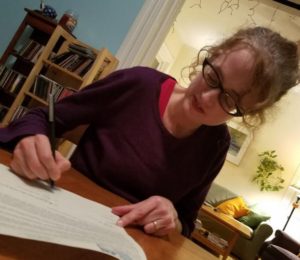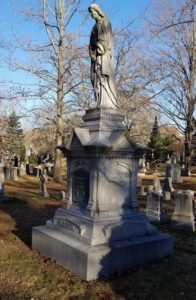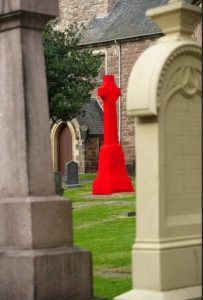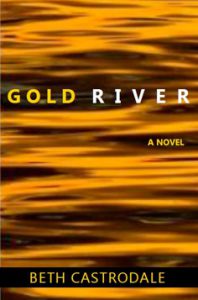
I’m delighted to announce that my next novel, In This Ground, will be published in September by Garland Press, which also brought out my first book, Marion Hatley.
As the title suggests, In This Ground is set almost entirely in a cemetery, in this case a shadowy, statued stage on which various dramas—those of the living and those who have died—play out and intersect. Connecting those stories is the novel’s central character, gravedigger-in-chief Ben Dirjery, who faces challenges of his own, both within and beyond the cemetery’s gates.
What’s with my interest in cemeteries? you may ask. And why did I make one the focus of a novel?
In cemeteries, I feel a story-inspiring sense of mystery.

Starting when we were in first or second grade, a close friend and I used to wander around a cemetery near our homes in a suburb of Pittsburgh. We loved checking out the stones, reading the names on them out loud, and making up stories about the lives we imagined these people to have led. (That friend, by the way, was Beth Gylys, now an accomplished poet.)
These days when I visit my favorite local cemetery (the lovely, historical Forest Hills), I still stop to read gravestones and think about the people buried beneath them. I wonder who loved and mourned these people, or who didn’t/couldn’t. I think of all the stories the dead took with them—many of these, surely, fleeting things quickly forgotten, or found unworthy of recording in a diary or telling to a friend. But among these stories, doubtlessly, are ones with the weight of layered soil, some “taken to the grave,” as the saying goes, in the most intentional of ways.
To a large degree, In This Ground grew out of a desire to respond to this sense of mystery. Through the novel, I’ve tried to imagine and then record the stories—some intensely private, others quite the opposite—of people who have been brought together by one trait: they are buried or have other business in the same cemetery, the same common ground.
So why did I put a gravedigger (Ben Dirjery) at the center of the novel? To me, Ben felt like the perfect connection between the living and dead within the world of the cemetery where he works, Bolster Hill. He tries to do his best by those buried there, by their friends and loved ones, and by members of the community who ask him such questions as, “Why don’t you guys offer green burials?”
Ben does whatever he can to advocate for these people, and for what he personally believes is best for the cemetery, even when that means pushing back against his managers. Although he’s a mere mortal, with all the attendant flaws, I think of him as a sort of demigod within the gates of the cemetery, which he regards as sacred ground.
Cemeteries host a good deal of drama, and it doesn’t stop at sundown.
While researching In This Ground, I had the privilege of spending a day with Bobby Burke, a gravedigger at a nearby cemetery, Fairview. One of the most striking things Bobby told me is that Fairview gets pretty steady traffic from sunup till sundown, and after—and not just from cemetery workers, attendees of memorial services, and those visiting the graves of friends or loved ones.
“Something about cemeteries brings out characters,” Bobby told me. He gave me several examples, such as people who are eager to visit gravestones that have already been etched with their names and birthdates. These folks, it seems, like to “see their name in lights,” Bobby said.
On the darker side, Fairview has been the site of drug deals, and sometimes, after nightfall, the scene of some pretty strange doings, including voodoo rituals. The paraphernalia of these rituals—headless chickens, rum bottles, burned-out candles, etc.—are left for grounds workers to clean up in the morning.
I was really struck by the notion of a cemetery being active at night; so a good amount of In This Ground takes place after hours. I won’t get into the details other than to say that Ben’s daughter becomes part of the after-hours crowd, just as he once did, and this sparks a confrontation between the two of them—and between Ben and his own past. (For years, he’s been troubled by guilt over the death of one of his old cemetery comrades, who is buried pretty much under Ben’s feet.)
Returning to my time with Bobby, I was probably most taken by the stories of his interactions with visitors—in particular, those in mourning. As he put it, “You have to be a good reader of people” to get a sense of whether they want to be left alone or have someone to talk to. Bobby said that when grieving visitors do welcome company, he can find himself in the role of a grief counselor or bartender, and that part of his job can be quite satisfying.
I’ve tried to weave the need for consolation, and attempts to provide it (through Ben), into In This Ground.
Cemeteries offer great settings for stories.
The setting of In This Ground, Bolster Hill Cemetery, was inspired by Forest Hills Cemetery, my favorite local graveyard and one of the gems of the garden, or rural, cemetery movement: a nineteenth-century trend of developing graveyards that look as much like Victorian-era parks as places to bury the dead.
As with Forest Hills Cemetery, Bolster Hill’s rolling grounds are home to countless monuments and statues, especially of winged figures; mausoleums like miniature mansions; and paths that wind past plots with all manner of gravestones, through stands of trees, and around ponds or lakes, sometimes leaving visitors disoriented, or lost.
In short, Bolster Hill Cemetery, like Forest Hills, offers plenty of opportunities to wander off and discover things, to retreat from ordinary life, or to connect with others–living or dead–in nooks of relative privacy. But it offers so much more than this, as one of the young nighttime visitors to Bolster Hill observes to his friends:
[T]he cemetery I grew up next to, it was kind of like an army barracks, just rows and rows of the same old kinds of stones. There was nothing interesting about it, and no place to hide. But this place, it’s like entering some kind of weird, twisty dream.”

I get the same feeling when I enter cemeteries like Forest Hills: that they’re on some other plane than the ordinary world and thus open to the imagination in unexpected ways. This quality becomes important to characters in In This Ground, such as a lyricist who finds inspiration on the grave of a fellow musician and a visual artist who, while resting in a garden at the cemetery, connects with memories of her late husband and as a result, with possibilities for a new work of art. (This turns out to be a “yarn bombing” of the garden.)
In the broadest sense, I see In This Ground as a kind of tribute to cemeteries, and maybe a sort of love letter to them. I hope that readers—even those who’ve never cared that much about cemeteries—will connect with the various characters and their stories and get a feeling for why these places have been so fascinating to me. If you end up being one of those readers, I’d love to hear what you think.

At first I thought this book seemed strange with it’s mix of music, mushrooms, and cemeteries, but even though I’m not quite finished reading it, I’ve found it to be intriguing. I love the characters. As a mushroom forager, an ex-wife of a musician, and lover of cemeteries, I find it fascinating. It makes me want to go right out and explore more cemeteries and, of course, discover more mushrooms,
Mary, I’m so glad you’re enjoying the book! Thanks so much for sharing your thoughts.